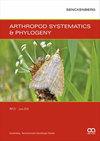Kuril Kamchatka海沟两种新的嗜木细胞介类介形虫(甲壳纲),并对Keysercythridae、Limnoythridae和Paradostomatidae科的系统学和系统发育进行了评述
IF 1.8
2区 农林科学
Q2 ENTOMOLOGY
引用次数: 3
摘要
Keysercythere reticulata sp.nov.和Redekea abyssalis sp.nov..是从千岛-堪察加海沟(西北太平洋)淹没的木材瀑布中收集的,它们只是5000米以上深度自然存在的、与木材相关的介形虫动物群的第二个记录。虽然Keysercythere Karanovic和Brandão,2015年的物种是自由生活的深海分类群,但所有Redekea de Vos,1953年的物种都共生在钻木等足类Limnoria spp.的体表。由于R.abyssalis是在深海中发现的唯一具有代表性的属,我们假设其祖先是由于共生关系而在这个生态系统中定居的。最新收集的材料使我们能够根据18S rRNA基因序列更新苏氨酸总科的分子系统发育,特别是阐明目前钥匙藻科、Limnocytheride科和Paradostomatidae科的系统学。由此产生的系统发育树支持了Keysercythere和Redekea之间的密切关系,以及两个Limnocytheridae谱系Timiriaseviinae和Limnocytherinae之间的遥远关系。因此,我们建议将Redekea从Paradostomatidae转移到Keysercytheridae,并在家族层面上建立两个鲎亚科。系统发育分析还表明,名义上的Limnocytherinae属与Keysercythere+Redekea分支之间存在密切关系,尽管后验概率较低,需要进一步研究来澄清这一点。本文章由计算机程序翻译,如有差异,请以英文原文为准。
Two new xylophile cytheroid ostracods (Crustacea) from Kuril-Kamchatka Trench, with remarks on the systematics and phylogeny of the family Keysercytheridae, Limnocytheridae, and Paradoxostomatidae
Keysercythere reticulata sp. nov. and Redekea abyssalis sp. nov., collected from the wood fall submerged in the Kuril-Kamchatka Trench (Northwestern Pacific), are only the second records of the naturally occurring, wood-associated ostracod fauna from a depth of over 5000 m. At the same time, K. reticulata is the second and R. abyssalis is the third representative of their respective genera. While Keysercythere Karanovic and Brandão, 2015 species are free-living, deep-sea taxa, all Redekea de Vos, 1953 live symbiotically on the body surface of wood-boring isopods, Limnoria spp. Since R. abyssalis is the only genus representative found in the deep sea, we hypothesize that its ancestor colonized this ecosystem as a result of the symbiotic relationship. Newly collected material enabled us to update molecular phylogeny of Cythreoidea based on 18S rRNA gene sequences, especially to clarify the current systematics of the families Keysercytheridae, Limnocytheridae, and Paradoxostomatidae. The resulting phylogenetic tree supports a close relationship between Keysercythere and Redekea and a distant relationship between two Limnocytheridae lineages, Timiriaseviinae and Limnocytherinae. Consequently, we propose a transfer of Redekea from Paradoxostomatidae to Keysercytheridae, and erecting of the two limnocytherid subfamilies onto the family level. The phylogenetic analysis also implies a close relationship between the nominal Limnocytherinae genus and Keysercythere+Redekea clade, albeit with a low posterior probability, requiring further studies to clarify this.
求助全文
通过发布文献求助,成功后即可免费获取论文全文。
去求助
来源期刊

Arthropod Systematics & Phylogeny
Agricultural and Biological Sciences-Insect Science
CiteScore
2.50
自引率
5.60%
发文量
26
审稿时长
12 weeks
期刊介绍:
Arthropod Systematics & Phylogeny releases three times per year. Research fields covered are the taxonomy, morphology/anatomy, phylogeny (molecular or morphology-based), historical biogeography and palaeontology of arthropod taxa.
Arthropod Systematics & Phylogeny is the successor of Entomologische Abhandlungen, formerly published by the Museum of Zoology Dresden, Germany.
 求助内容:
求助内容: 应助结果提醒方式:
应助结果提醒方式:


